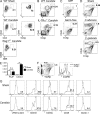Oral-resident natural Th17 cells and γδ T cells control opportunistic Candida albicans infections
- PMID: 25200028
- PMCID: PMC4172215
- DOI: 10.1084/jem.20130877
Oral-resident natural Th17 cells and γδ T cells control opportunistic Candida albicans infections
Abstract
Oropharyngeal candidiasis (OPC) is an opportunistic fungal infection caused by Candida albicans. OPC is frequent in HIV/AIDS, implicating adaptive immunity. Mice are naive to Candida, yet IL-17 is induced within 24 h of infection, and susceptibility is strongly dependent on IL-17R signaling. We sought to identify the source of IL-17 during the early innate response to candidiasis. We show that innate responses to Candida require an intact TCR, as SCID, IL-7Rα(-/-), and Rag1(-/-) mice were susceptible to OPC, and blockade of TCR signaling by cyclosporine induced susceptibility. Using fate-tracking IL-17 reporter mice, we found that IL-17 is produced within 1-2 d by tongue-resident populations of γδ T cells and CD3(+)CD4(+)CD44(hi)TCRβ(+)CCR6(+) natural Th17 (nTh17) cells, but not by TCR-deficient innate lymphoid cells (ILCs) or NK cells. These cells function redundantly, as TCR-β(-/-) and TCR-δ(-/-) mice were both resistant to OPC. Whereas γδ T cells were previously shown to produce IL-17 during dermal candidiasis and are known to mediate host defense at mucosal surfaces, nTh17 cells are poorly understood. The oral nTh17 population expanded rapidly after OPC, exhibited high TCR-β clonal diversity, and was absent in Rag1(-/-), IL-7Rα(-/-), and germ-free mice. These findings indicate that nTh17 and γδ T cells, but not ILCs, are key mucosal sentinels that control oral pathogens.
© 2014 Conti et al.
Figures




References
-
- Bishu, S., Hernández-Santos N., Simpson-Abelson M.R., Huppler A.R., Conti H.R., Ghilardi N., Mamo A.J., and Gaffen S.L.. 2014. The adaptor CARD9 is required for adaptive but not innate immunity to oral mucosal Candida albicans infections. Infect. Immun. 82:1173–1180 10.1128/IAI.01335-13 - DOI - PMC - PubMed
-
- Boisson, B., Wang C., Pedergnana V., Wu L., Cypowyj S., Rybojad M., Belkadi A., Picard C., Abel L., Fieschi C., et al. . 2013. An ACT1 mutation selectively abolishes interleukin-17 responses in humans with chronic mucocutaneous candidiasis. Immunity. 39:676–686 10.1016/j.immuni.2013.09.002 - DOI - PMC - PubMed
Publication types
MeSH terms
Substances
Grants and funding
- DE023815/DE/NIDCR NIH HHS/United States
- R37 DE022550/DE/NIDCR NIH HHS/United States
- R01 AI095466/AI/NIAID NIH HHS/United States
- P01 AI106697/AI/NIAID NIH HHS/United States
- AI1110822/AI/NIAID NIH HHS/United States
- U54 GM103529/GM/NIGMS NIH HHS/United States
- DE022550/DE/NIDCR NIH HHS/United States
- T32 DK063922/DK/NIDDK NIH HHS/United States
- F32-AI098243/AI/NIAID NIH HHS/United States
- R01 DE022550/DE/NIDCR NIH HHS/United States
- F32 AI098243/AI/NIAID NIH HHS/United States
- R01 AI107825/AI/NIAID NIH HHS/United States
- F32 DE023293/DE/NIDCR NIH HHS/United States
- R01 DE023815/DE/NIDCR NIH HHS/United States
- AI106697/AI/NIAID NIH HHS/United States
- R56 AI110822/AI/NIAID NIH HHS/United States
- AI107825/AI/NIAID NIH HHS/United States
- R01 AI097333/AI/NIAID NIH HHS/United States
- AI095466/AI/NIAID NIH HHS/United States
- F32-DE023293/DE/NIDCR NIH HHS/United States
- T32-DK063922/DK/NIDDK NIH HHS/United States
- AI097333/AI/NIAID NIH HHS/United States
LinkOut - more resources
Full Text Sources
Other Literature Sources
Medical
Molecular Biology Databases
Research Materials
Miscellaneous

